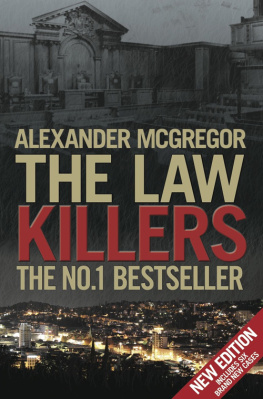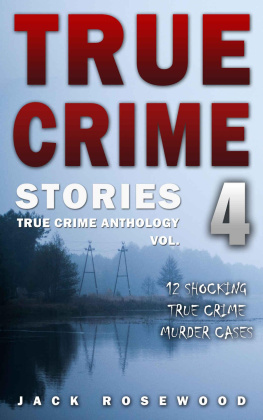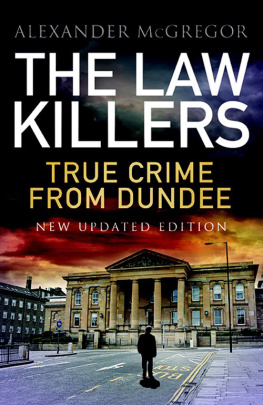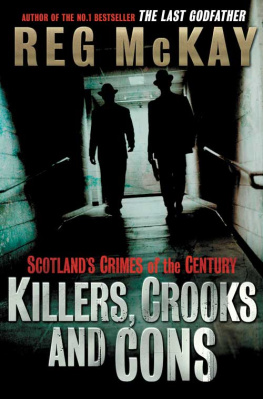McGregor - The law killers : true crime from Dundee
Here you can read online McGregor - The law killers : true crime from Dundee full text of the book (entire story) in english for free. Download pdf and epub, get meaning, cover and reviews about this ebook. City: Edinburgh, Scotland--Dundee, year: 2009, publisher: Black & White Publishing, genre: Detective and thriller. Description of the work, (preface) as well as reviews are available. Best literature library LitArk.com created for fans of good reading and offers a wide selection of genres:
Romance novel
Science fiction
Adventure
Detective
Science
History
Home and family
Prose
Art
Politics
Computer
Non-fiction
Religion
Business
Children
Humor
Choose a favorite category and find really read worthwhile books. Enjoy immersion in the world of imagination, feel the emotions of the characters or learn something new for yourself, make an fascinating discovery.
- Book:The law killers : true crime from Dundee
- Author:
- Publisher:Black & White Publishing
- Genre:
- Year:2009
- City:Edinburgh, Scotland--Dundee
- Rating:3 / 5
- Favourites:Add to favourites
- Your mark:
- 60
- 1
- 2
- 3
- 4
- 5
The law killers : true crime from Dundee: summary, description and annotation
We offer to read an annotation, description, summary or preface (depends on what the author of the book "The law killers : true crime from Dundee" wrote himself). If you haven't found the necessary information about the book — write in the comments, we will try to find it.
The law killers : true crime from Dundee — read online for free the complete book (whole text) full work
Below is the text of the book, divided by pages. System saving the place of the last page read, allows you to conveniently read the book "The law killers : true crime from Dundee" online for free, without having to search again every time where you left off. Put a bookmark, and you can go to the page where you finished reading at any time.
Font size:
Interval:
Bookmark:
Nobody paid him any attention. He was just a young soldier who seemed to know exactly where he was going as he walked purposefully through the gates of St Johns RC secondary school in Dundee one afternoon in 1967. He spoke to no one, for 19-year-old Robert Francis Mone had other things on his mind. He had been a pupil at the school until being expelled a few years earlier and had gone from there to an approved school. Now he was dressed in the uniform of a private in the Gordon Highlanders and carried a long, narrow object wrapped in brown paper. Still, no one gave him more than a second glance or asked what his business was.
It was 2.15 p.m. on 1 November All Saints Day, a bizarre irony, given the terrible events that were about to unfold. On the top floor of the school, 26-year-old teacher Nanette Hanson was beginning a needlework lesson with eleven third-year girl pupils when the door burst open and the slightly built soldier ripped the paper away from his package to reveal a shotgun. The girls giggled. It was nothing more than a prank by a stupid show-off wanting attention. Mrs Hanson would soon sort him out.
Almost instantly they knew they could not be more wrong. The intruder, his eyes flashing wildly round the room, began to shout and swear, waving the gun at the girls and ordering the 14- and 15-year-olds, some of them now crying, to barricade the door with their sewing tables and that was the start of an ordeal that was to last for two hours. It was also the opening sequence of a chain of events that was to reverberate for more than a decade, leaving eight people dead and making the name Mone one of the most feared in the whole of Scotland. Additionally, it bestowed on Dundee the unwanted distinction of being the birthplace of a father and son unrivalled for wickedness.
In the needlework room, a new order was being imposed. The sandy-haired youth who had thrust his way into the class was now sitting on the teachers desk and issuing instructions. He produced ammunition from his pockets and lined it up along the front of the desk. He told the pupils he would blow their heads off and one by one asked the girls their ages. Some were so afraid they could barely respond. Others whispered to each other and one even suggested to a classmate that they seize an iron from another part of the room and attack their captor with it. When Mrs Hanson just seven months married told Mone she was aged 26, he mocked Youre just a pensioner. Then he snatched her glasses from her face, threw them to the floor and trampled the glass into the wooden boards with his army boot. When some of the pupils sobbed too loudly, the gun was put to their head and they were advised to keep quiet or he would silence them.
He ordered everyone into a small changing-room attached to the sewing section and began strutting back and forth, his eyes bulging in their sockets. He smirked as he told his hostages that he had come to the school to gain revenge for being expelled. In particular, he sought retribution against one of the Marist Brothers who helped oversee the Roman Catholic education in the school. Mrs Hanson was the calmest person present. She spoke softly to the young man with the gun and gently advised the girls to stop crying because they might use up the limited amount of air in the small ante-room that had now become a prison. She repeatedly tried to reason with their captor, pleading with him to release the girls and to detain just her.
Outside, the sounds of disturbance had attracted the attention of Miss Margaret Christie, head of the domestic science department, who taught in an adjoining classroom. Puzzled by the unexpected noise emanating from what was normally the quietest class in the entire school, she went to investigate and found that the upper glass panel in the door had been screened with dressmaking material. As she stood outside the room with another needlework teacher, some of the cloth was moved away and she could see Mrs Hanson making her way in their direction.
Then a blast of gunfire almost deafened them. Glass in the top half of the door showered over the pair, sending piercing shards into Miss Christie. Ignoring the pain and emerging blood, she fled with her teacher companion back along the corridor to alert the rest of the school to the frightening events taking place on the upper floor.
If any of those being detained inside the room had any doubts about the seriousness of their position, they now knew better. Some of the pupils screamed. Most of them wept.
Within minutes of the shot ringing out, police began converging on the school and the usually peaceful Harefield Road area found itself ringed by blue flashing lights and vehicles from all the emergency services. News of the siege quickly found its way on to radio news bulletins and media teams from across the country raced to the city. Among those hearing of the dramatic events unfolding in their home town were the members of the Dundee Police football team, taking part in a cup-final tie a hundred miles away.
Meanwhile, a state of emergency had been declared at St Johns and the other thousand pupils were rapidly evacuated from the cordoned-off building. Three police officers, backed by a team carrying riot shields, made their way to the upper-floor corridor. Detective Superintendent Donald Robertson the Clark Gablelookalike head of CID Detective Chief Inspector William Melville and Sergeant George McLaren hoped to negotiate with Mone, but the moment they approached the vicinity of the shattered door window, they were treated to blasts from the shotgun.
An impasse appeared to have been reached. Officers shouted suggestions that they should enter the room to speak with him. Each offer was met with the warning that they should keep back or the gun would be turned on the girls. One of the 14-year-old hostages was led to the door and had the gun pointed at her head while Mone called out that she would be the first to die if anyone tried to force an entry.
By now adrenalin was surging through his body and he was becoming increasingly aggressive towards the terrified pupils. Three of the girls were ordered at gun-point from the changing-room where the heat was almost intolerable into the main classroom. He kissed one of them and sexually interfered with the other two. He exuded power and, to demonstrate his absolute control, he released one 15-year-old, instructing her to inform the growing number of people gathering on the ground floor that he should be left alone. She hurried downstairs to carry out his order just as plans of the school were being scrutinised to determine if there was a possible route into the classroom.
At the point when police were considering ending the deadlock with tear gas, Mone called out that the only person he would be prepared to speak to was a girl who had lived near him in the houses on the northern edge of the Law, the hill that had been his childhood playground. Her name was Marion Young and they had met four years earlier at a youth club. They had hit it off together and, he explained, she seemed to understand him.
By good fortune, police were able to make quick contact with her and she was rushed under escort to the scene. Then aged 18 and a student nurse, she unhesitatingly volunteered to go into the classroom to negotiate with Mone. Police were reluctant to allow the gunman another hostage and indicated that the negotiations should take place from behind the door. Marion knew this was not what her long-forgotten acquaintance wanted and insisted she go into the room, as this would offer the best chance of the petrified pupils being released. After some hesitation, police agreed. Seventy-five minutes after the siege had begun, Marion found herself face to face with the baby-faced ex-pupil she now hardly recognised.
Mone had eagerly anticipated the meeting. Awaiting her arrival, he filled one of the classroom sinks with water and washed his face and hair. Then he sat singing to himself while police sped Marion across the city. His first words to her werent exactly the customary greeting of old friends: You thought you were being a brave little girl? How did you know I wouldnt blow your head off? he asked with a small smile.
Font size:
Interval:
Bookmark:
Similar books «The law killers : true crime from Dundee»
Look at similar books to The law killers : true crime from Dundee. We have selected literature similar in name and meaning in the hope of providing readers with more options to find new, interesting, not yet read works.
Discussion, reviews of the book The law killers : true crime from Dundee and just readers' own opinions. Leave your comments, write what you think about the work, its meaning or the main characters. Specify what exactly you liked and what you didn't like, and why you think so.











